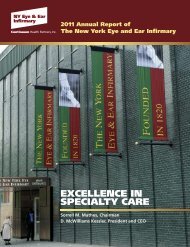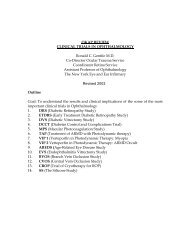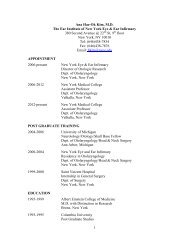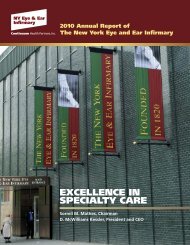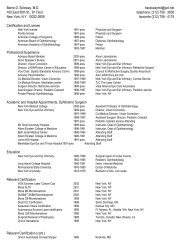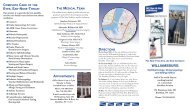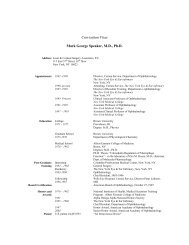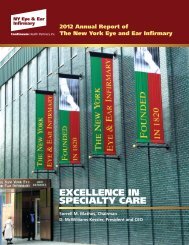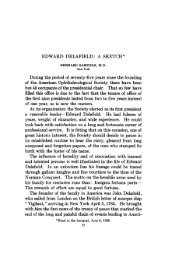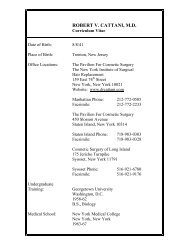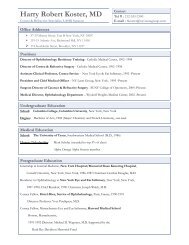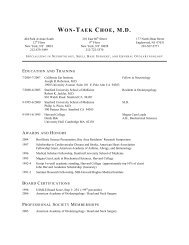Prevention and Management of Ocular Inflammation - New York Eye ...
Prevention and Management of Ocular Inflammation - New York Eye ...
Prevention and Management of Ocular Inflammation - New York Eye ...
You also want an ePaper? Increase the reach of your titles
YUMPU automatically turns print PDFs into web optimized ePapers that Google loves.
• Postoperatively: Besifloxacin remains for 1 week, bromfenac<br />
<strong>and</strong> difluprednate for 4 weeks. Besifloxacin dosed bid, bromfenac<br />
qd, <strong>and</strong> difluprednate bid. Difluprednate tapered to qd<br />
after 2 weeks, provided inflammation appears normal at<br />
1-week follow-up. Continue corticosteroids <strong>and</strong> NSAIDs for 4 to<br />
6 weeks<br />
For high-risk patients: May start the NSAID a week prior to surgery<br />
Keratorefractive Procedures<br />
For keratorefractive procedures, the bar is raised even higher because<br />
the procedure is an elective one. A problem for the keratorefractive<br />
surgeon is the fact that subtle subclinical factors may lead to inflammation<br />
<strong>and</strong> a negative outcome.<br />
Dr O'Brien: Dr Donnenfeld, please outline those conditions that you<br />
worry may not be detected in a routine screening. What do you do in<br />
your practice to aggressively screen patients for risk factors?<br />
Dr Donnenfeld: Today, the most common problem facing the LASIK<br />
surgeon <strong>and</strong> patient is the effect <strong>of</strong> ocular surface disease <strong>and</strong> dry eye<br />
on postsurgical results. I think more attention has to be paid to ocular<br />
surface dry eye disease. Tear break-up time (TBUT) is important, but<br />
new point-<strong>of</strong>-service tests, such as tear osmolarity <strong>and</strong> the matrix metalloproteinase<br />
(MMP)-9 test, <strong>of</strong>fer great promise in helping diagnose<br />
dry eye. 44–46 A st<strong>and</strong>ardized preoperative evaluation with specific testing<br />
will allow us to screen those patients who are at risk <strong>and</strong> to treat<br />
their underlying conditions to make them better refractive surgery c<strong>and</strong>idates.<br />
<strong>Inflammation</strong> still plays a very important role in management<br />
<strong>of</strong> LASIK patients.<br />
Dr O'Brien: Dr Pflugfelder, surveys have consistently shown that dry<br />
eye is the single greatest reason for patient dissatisfaction with keratorefractive<br />
procedures. What are some <strong>of</strong> the limitations <strong>of</strong> the current<br />
clinical methods <strong>and</strong> diagnostic tests for uncovering dry eye in those<br />
who are seeking LASIK procedures?<br />
Dr Pflugfelder: The current clinical methods for detecting ocular surface<br />
problems or tear dysfunction are fairly poor. Dye staining <strong>and</strong> TBUT<br />
may be the best tests that we use, but both are relatively insensitive.<br />
Another problem is that many <strong>of</strong> the people with potential problems<br />
do not actually have a classic dry eye, but more <strong>of</strong> a tear distribution<br />
or tear clearance problem. Detecting biomarkers—either in the tears<br />
or in ocular surface cells—would go a long way toward improving<br />
presurgical testing.<br />
Dr O'Brien: We have mentioned the lack <strong>of</strong> clear guidelines for the<br />
practicing keratorefractive surgeon in cataract surgery <strong>and</strong> I think guidelines<br />
are even less clear for the refractive surgeon, but are there some<br />
general ones to follow based on organizational recommendations?<br />
Dr Lane: There is a dearth <strong>of</strong> information about this, so we all have<br />
developed our own regimens. The 2 things that I am most concerned<br />
about are reducing the pain <strong>and</strong> inflammation associated with the surgery<br />
<strong>and</strong> then using an agent that is very efficacious <strong>and</strong> very safe to<br />
the ocular surface. I do use a drop <strong>of</strong> a nonsteroidal when the patient<br />
is on the operating table to try to limit the pain <strong>and</strong> discomfort experienced<br />
immediately afterward, but I do not send my patients home<br />
with a bottle <strong>of</strong> nonsteroidal medication. I also prescribe loteprednol<br />
<strong>and</strong> very frequent doses <strong>of</strong> preservative-free artificial tears.<br />
Dr Karpecki: I think that preoperative management <strong>of</strong> ocular surface<br />
disease, including blepharitis, dry eye, <strong>and</strong> meibomian gl<strong>and</strong> dysfunction<br />
(MGD), is one <strong>of</strong> the most critical aspects <strong>of</strong> successful refractive<br />
surgery outcomes. Research has shown not only a potential for worse<br />
vision after surgery due to a poor tear film, but also a much higher<br />
enhancement rate. 47<br />
So, if osmolarity is above 308 mOsmol/L 48 or if lissamine green or fluorescein<br />
staining is present, then treatment <strong>of</strong> the ocular surface with<br />
loteprednol <strong>and</strong> cyclosporine, for example, is critical (Figure 2). And if<br />
the signs <strong>of</strong> dry eye can’t be improved, the patient should not be a<br />
c<strong>and</strong>idate for surgery. That being said, typically we can improve signs<br />
<strong>of</strong> dry eye in 98% <strong>of</strong> patients prior to surgery, <strong>and</strong> we are likely grateful<br />
we did not recommend LASIK for the other 2%.<br />
Figure 2. Lissamine<br />
green staining.<br />
Photo Courtesy <strong>of</strong><br />
Eric D. Donnenfeld, MD<br />
Dr O'Brien: Historically, we discovered the role <strong>of</strong> ophthalmic non -<br />
steroidals for controlling pain after excimer phototherapeutic keratectomy<br />
<strong>and</strong> photorefractive keratectomy (PRK). I have patients use a<br />
nonsteroidal once a day or twice a day for a short period <strong>of</strong> time. I am<br />
not sure it changes the outcome, yet patients seem very comfortable,<br />
without significant pain.<br />
Dr Pepose: I use an NSAID preoperatively <strong>and</strong> intraoperatively for my<br />
LASIK patients, mostly for pain relief. It is also very important to assess<br />
<strong>and</strong> aggressively treat dry eye, ocular surface disease, <strong>and</strong> MGD in this<br />
cohort <strong>and</strong> to optimize the ocular surface prior to refractive surgery. At<br />
least 30% <strong>of</strong> these patients who come in with dry eyes are completely<br />
asymptomatic, so you really cannot rely on their history alone. 49 I do<br />
test tear osmolarity <strong>and</strong> perform vital dye staining on all these refractive<br />
surgery patients. I think it is very important to look at the lid because<br />
70% <strong>of</strong> dry eye is probably from MGD. 50 Without treatment <strong>of</strong> dry eye<br />
prior to <strong>and</strong> following the LASIK procedure, many <strong>of</strong> these patients are<br />
setups for a less than optimal outcome. 48<br />
Dr O'Brien: One <strong>of</strong> the things that we must do when we detect ocular<br />
surface disease, blepharitis, dry eye, or ocular allergy, is to stop the<br />
refractive screening at that point. We should initiate aggressive treatment<br />
for 4 to 6 weeks <strong>and</strong> then reexamine the patient at a later date.<br />
Is that a strategy that we can use as a guideline?<br />
Dr Donnenfeld: I agree completely. I use my “traffic light” analogy. If I<br />
see rose bengal red, lissamine green, or fluorescein yellow—the colors<br />
<strong>of</strong> a traffic light—all those tell me “Stop!”—Stop <strong>and</strong> Reassess. This<br />
cautionary step applies not only to LASIK but to cataract surgery as well.<br />
Dr O’Brien: There has been controversy about the use <strong>of</strong> cortico -<br />
steroids; our colleagues in Europe, in the early days, did not use corticosteroids<br />
in refractive surgery. Yet in the United States, the use <strong>of</strong><br />
corticosteroids persisted beyond the FDA trials. Dr Lane, do you still<br />
use corticosteroids in surface ablations as well as in lamellar refractive<br />
procedures?<br />
Dr Lane: Absolutely. With surface ablations, we are dealing with the<br />
same issues <strong>of</strong> pain <strong>and</strong> inflammation as with lamellar refractive procedures,<br />
but to an even greater extent, so it is really no different. The<br />
best treatment for pain <strong>and</strong> inflammation that we have available today<br />
are the corticosteroids. We have an array <strong>of</strong> options, depending on the<br />
severity <strong>of</strong> the inflammation <strong>and</strong> on the comorbidities encountered. It<br />
is important to emphasize that this is a younger population <strong>of</strong> patients<br />
that we are operating on, <strong>and</strong> the effect <strong>of</strong> some <strong>of</strong> the ketone steroids<br />
for induction <strong>of</strong> cataracts is not to be dismissed. The corticosteroid<br />
should provide a dual combination <strong>of</strong> potency <strong>and</strong> safety.<br />
The nice thing, in contrast to cataract surgery, is that the inflammatory<br />
process is usually a lot shorter, especially with regard to lamellar refractive<br />
surgery. So my regimen for topical steroids in lamellar surgery is<br />
usually only about a week. With surface ablation, I will vary the length<br />
<strong>of</strong> treatment depending on the presence <strong>of</strong> comorbidities or the<br />
amount <strong>of</strong> ablation that takes place. Depending on the ablation, I can<br />
prescribe steroids for as long as 3 months (Figure 3).<br />
Dr Pepose: In a review article, Dr Donnenfeld had pointed out the<br />
effect <strong>of</strong> corticosteroids on cell preservation; regarding surface treatment,<br />
we really want to limit the amount <strong>of</strong> apoptosis. 31 Keratocytes<br />
subsequently migrate in <strong>and</strong> are transformed into my<strong>of</strong>ibroblast cells, 51<br />
7



